Topic 11: Animal physiology (HL)
11.3 The kidney and osmoregulation
Osmolarity: how much solute are dissolved in a solution
- Osmoregulators maintain a constant internal solute concentration,
- All terrestrial animals, freshwater animals and some marine organisms are osmoregulators
- Osmoconformers are animals that have similar internal solute concentration in comparison to the solute concentration of their surrounding environment
Malpighian tubule
- Insects have a circulating fluid known as hemolymph, that combines the features of blood and tissue fluid
- Osmoregulation is a form of homeostasis to keep the concentration of hemolymph or blood within a certain range
- Nitrogenous waste is created by the breakdown of amino acids and is toxic to the organism
- In insects the waste is in the form of uric acid and in mammals it is urea
- Insects have Malpighian tubules that branch off from their intestinal tract to get rid of this waste
- Cells in these tubules actively transport the uric acid and ions from the hemolymph into the lumen of the tubules
- Water is then drawn into the lumen by osmosis due to a high concentration in Malpighian tubule
- The tubules empty into the gut
- When it reaches the hindgut, water and salts are reabsorbed and the nitrogenous waste is excreted in the feces of the insect
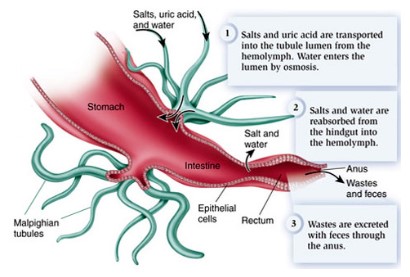
Renal System
- Filter the blood off excess salts, water and the complete removal of urea
- Regulates the acidity of the blood
- 25% of blood flows through a kidney per minute
- blood in renal artery is more oxygenated than the blood in the renal vein / oxygenated versus deoxygenated
- blood in renal artery contains more urea than the blood in the renal vein
- variable water / salt content in renal artery but constant / correct / regulated content in vein
- Toxins and other substances that are ingested and absorbed but are not yet fully metabolized by the body are present in higher con centrations in the renal artery than in the renal vein
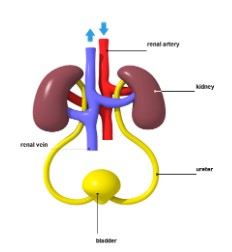
Diagram of kidney
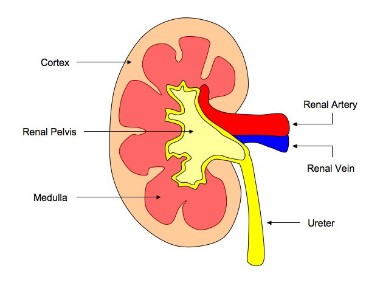
Nephron
- Filtering units of the kidney
- Located within the cortex and medulla
- Highly vascular for absorption
- Consisted of glomerulus, Bowman’s capsule, proximal convoluted tubule, loop of Henle, distal convoluted tubule, collecting duct
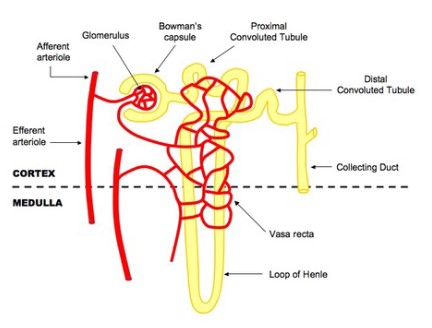
Renal capsule – untrafilteration
- Ultrafiltration is the non-specific filtration of the blood as it enters the Bowman’s capsule of the kidney in which created by the high pressure in the glomerulus (capillaries) forces a liquid against a semi-permeable
membrane. - As blood enters the kidney through the afferent arteriole it becomes a knot-like capillary bed known as the glomerulus.
- Because of the high pressure created in the capillaries as the blood vessel become smaller and because the glomerulus has fenestrations (small pores), large suspended solids and solutes such as proteins are retained. Water and small solutes such as salts, glucose and waste (urea) pass through the membrane into the Bowman’s capsule.
- The large surface area, high pressure and pores in the membrane enables ultrafiltration
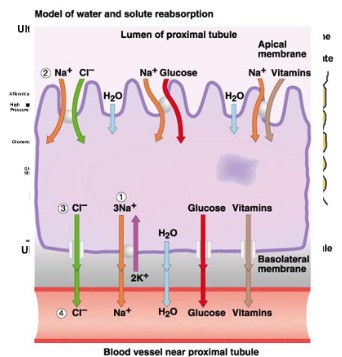
Proximal convoluted tubule
- While ultrafiltration is non-specific with regards to the molecules that leave the blood (based on size, no specific channels), selective reabsorption in the proximal convoluted tubule (PCT) is very specific with regards to the molecules that are reabsorbed.
- Active transport of \(Na^+\) ions from PCT cells to the blood
- Diffusion of \(Na^+\) ions from the lumen of PCT into the PCT cells (concentration gradient)
- Cotransport of amino acids and glucose to PCT cells with \(Na^+\) ions
- Facilitated diffusion of amino acids and glucose from PCT cells to blood
- Water moves back to the blood by osmosis, since there will be higher solute concentration in the blood.
• The wall of the proximal convoluted tubule is only one cell thick allowing for efficient movement of molecules across a short distance.
• The wall also contains microvilli (similar to the small intestine) that increase the surface area for reabsorption of important molecules.
Loop of Henle
- The descending loop of Henle is permeable to water but impermeable to salt ions.
- The ascending loop of Henle is permeable to salt ions but impermeable water.
- As the filtrate flows up the ascending loop \(Na^+\) ions are pumped out of the filtrate into the medulla thus increasing the solute concentration in the medulla.
- As the filtrate flows down the descending loop (before the ascending loop) water flows out of the filtrate into the medulla by osmosis following the concentration gradient creating by pumping \(Na^+\) ions out of the ascending loop.
- Therefore the medulla has a very high concentration of \(Na^+\) ions
- This system is countercurrent because the flow of the filtrate in the descending and ascending loop is in opposite directions. This allows for a greater concentration gradient to be created in the medulla.
- Overall, salts are removed and solute concentration decreases. Some water is also removed
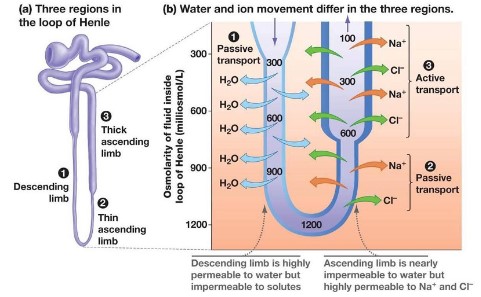
Collecting duct
- Reabsorb water to blood
- Controlled by antidiuretic hormone (ADH)
- If the solute concentration in the blood is too high, osmoreceptors in the hypothalamus sense this and signal the pituitary gland to produce a hormone called ADH (anti-diuretic hormone).
- ADH causes special pores called aquaporins in the collecting duct to open, allowing water to be reabsorbed back into the blood, thus making the blood more dilute.
- If the solute concentration in the blood is too low, osmoreceptors in the hypothalamus sense this and signal the pituitary gland to reduce its production of ADH.
- This causes the aquaporins in the collecting duct to close, keeping the excess water in the filtrate, which excreted as dilute urine.
- This is called osmoregulation.
- So, the increase in ADH causes more aquaporins, thus more water will be absorbed, resulting in a more concentrated urine
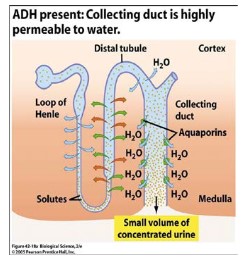
The length of loop of Henle
- The longer the loop of Henle, the more water will be reabsorbed
- Therefore, animals that live in dry habitats such as the desert have a long loop of Henle
- This means the medulla of the kidney is also thicker
Nitrogen waste
- When animals breakdown amino and nucleic acids, nitrogenous waste is formed in the form of ammonia
- Ammonia is highly basic, toxic and can be very reactive
- Marine and freshwater organisms can release the ammonia directly into the surrounding water
- Terrestrial organisms convert ammonia into a less toxic form (urea or uric acid) before excretion
- What form depends on the animals evolutionary history and habitat
- Amphibians release waste as ammonia as larvae and urea as adults
- Birds and insects release ammonia as uric acid. Uric acid does not require water and is highly concentrated but cost more energy.
- Mammals release their waste in the less toxic form known as urea